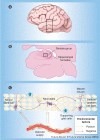Insights into neurogenesis and aging: potential therapy for degenerative disease?
- PMID: 20806052
- PMCID: PMC2929019
- DOI: 10.2217/FNL.10.33
Insights into neurogenesis and aging: potential therapy for degenerative disease?
Abstract
Neurogenesis is the process by which new neural cells are generated from a small population of multipotent stem cells in the adult CNS. This natural generation of new cells is limited in its regenerative capabilities and also declines with age. The use of stem cells in the treatment of neurodegenerative disease may hold great potential; however, the age-related incidence of many CNS diseases coincides with reduced neurogenesis. This review concisely summarizes current knowledge related to adult neurogenesis and its alteration with aging and examines the feasibility of using stem cell and gene therapies to combat diseases of the CNS with advancing age.
Figures


Similar articles
-
Therapeutic potential of neurogenesis for prevention and recovery from Alzheimer's disease: allopregnanolone as a proof of concept neurogenic agent.Curr Alzheimer Res. 2006 Jul;3(3):185-90. doi: 10.2174/156720506777632817. Curr Alzheimer Res. 2006. PMID: 16842093 Review.
-
EphA4 Targeting Peptide-Conjugated Extracellular Vesicles Rejuvenates Adult Neural Stem Cells and Exerts Therapeutic Benefits in Aging Rats.ACS Chem Neurosci. 2024 Oct 2;15(19):3482-3495. doi: 10.1021/acschemneuro.4c00331. Epub 2024 Sep 17. ACS Chem Neurosci. 2024. PMID: 39288278
-
Neurogenesis in aging and age-related neurodegenerative diseases.Ageing Res Rev. 2022 Jun;78:101636. doi: 10.1016/j.arr.2022.101636. Epub 2022 Apr 29. Ageing Res Rev. 2022. PMID: 35490966 Free PMC article. Review.
-
Adult neurogenesis as a potential therapy for neurodegenerative diseases.Discov Med. 2006 Aug;6(34):144-7. Discov Med. 2006. PMID: 17234134
-
Aging and neurogenesis, a lesion from Alzheimer's disease.Aging Dis. 2010 Oct;1(2):158-68. Epub 2010 Apr 28. Aging Dis. 2010. PMID: 22396863 Free PMC article.
Cited by
-
Hippocampal injury-induced cognitive and mood dysfunction, altered neurogenesis, and epilepsy: can early neural stem cell grafting intervention provide protection?Epilepsy Behav. 2014 Sep;38:117-24. doi: 10.1016/j.yebeh.2013.12.001. Epub 2014 Jan 13. Epilepsy Behav. 2014. PMID: 24433836 Free PMC article. Review.
-
Comparison of Bispectral Index-Guided Individualized Anesthesia with Standard General Anesthesia on Inadequate Emergence and Postoperative Delirium in Elderly Patients Undergoing Esophagectomy: A Retrospective Study at a Single Center.Med Sci Monit. 2020 Oct 1;26:e925314. doi: 10.12659/MSM.925314. Med Sci Monit. 2020. PMID: 33001868 Free PMC article.
-
Changes in the Bispectral Index in Response to Loss of Consciousness and No Somatic Movement to Nociceptive Stimuli in Elderly Patients.Chin Med J (Engl). 2016 Feb 20;129(4):410-6. doi: 10.4103/0366-6999.176083. Chin Med J (Engl). 2016. PMID: 26879014 Free PMC article.
-
The Ageing Brain: Age-dependent changes in the electroencephalogram during propofol and sevoflurane general anaesthesia.Br J Anaesth. 2015 Jul;115 Suppl 1(Suppl 1):i46-i57. doi: 10.1093/bja/aev213. Br J Anaesth. 2015. PMID: 26174300 Free PMC article.
-
The Impact of Ghrelin in Metabolic Diseases: An Immune Perspective.J Diabetes Res. 2017;2017:4527980. doi: 10.1155/2017/4527980. Epub 2017 Sep 7. J Diabetes Res. 2017. PMID: 29082258 Free PMC article. Review.
References
-
- Center for Health Workforce Studies . The Impact of the Aging Population on the Health Workforce in the United States: Summary of Key Findings. Center for Health Workforce Studies; NY, USA: 2006. - PubMed
-
- Olanow CW, Stern MB, Sethi K. The scientific and clinical basis for the treatment of Parkinson disease. Neurology. 2009;72(21 Suppl. 4):S1–S136. - PubMed
-
- Kempermann G, Jessberger S, Steiner B, Kronenberg G. Milestones of neuronal development in the adult hippocampus. Trends Neurosci. 2004;27(8):447–452. - PubMed
Grants and funding
LinkOut - more resources
Full Text Sources
